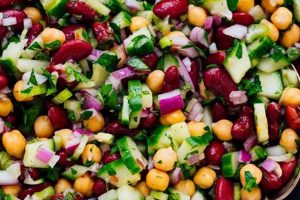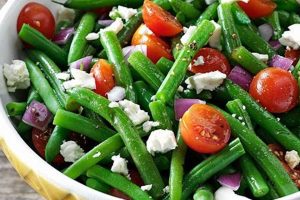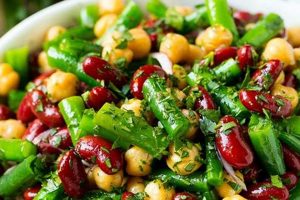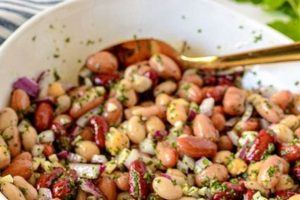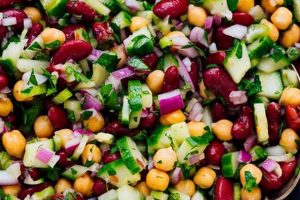This vibrant dish typically combines black beans, corn kernels, diced avocado, and often other fresh ingredients like red onion, bell pepper, and cilantro. A simple vinaigrette, sometimes with lime juice and cumin, typically dresses the salad. Variations can include other legumes, different vegetables, or even grilled chicken or fish for added protein.
The combination of ingredients offers a nutritionally dense and flavorful meal option. Legumes provide protein and fiber, while corn contributes carbohydrates and antioxidants. Avocado adds healthy fats and a creamy texture. Such salads are versatile, suitable as a light lunch, a side dish, or a component of a larger meal. They also offer an opportunity to incorporate seasonal produce and adapt to dietary preferences, such as vegan or gluten-free diets.
Further exploration could include variations on the basic formula, nutritional information, tips for ingredient selection and preparation, and suggested serving ideas. Different dressing options and techniques for achieving optimal flavor and texture will also be considered.
Tips for a Superior Black Bean, Corn, and Avocado Salad
Creating a truly exceptional salad involves attention to detail and thoughtful ingredient selection. These tips offer guidance for optimizing flavor and texture.
Tip 1: Ripe but Firm Avocados: Avocados should yield to gentle pressure but not feel mushy. This ensures optimal creaminess without compromising the salad’s structural integrity.
Tip 2: Fresh Corn: Whenever possible, use fresh corn cut from the cob. Frozen corn can be substituted, but thawed and drained thoroughly before adding.
Tip 3: Balancing Flavors: Consider the acidity of the dressing. Lime juice provides brightness, while a touch of sweetness can balance spicier elements.
Tip 4: Textural Variety: A mix of textures enhances the eating experience. Chopped red onion adds a crisp bite, while diced bell peppers contribute a subtle crunch.
Tip 5: Proper Bean Preparation: Rinse canned black beans thoroughly to remove excess sodium and starch. This improves both flavor and texture.
Tip 6: Seasoning Timing: Season the individual components (beans, corn) separately before combining. This ensures even flavor distribution.
Tip 7: Don’t Overdress: Add the dressing gradually, tossing gently to coat. Too much dressing can make the salad soggy.
Tip 8: Serve Immediately: This type of salad is best enjoyed fresh. If making ahead, combine ingredients just before serving to prevent the avocado from browning.
By following these guidelines, one can elevate this simple salad into a culinary delight, maximizing the flavors and textures of each ingredient.
These tips represent a starting point. Experimentation and personal preference ultimately determine the ideal combination of ingredients and techniques.
1. Fresh Ingredients
Ingredient quality significantly impacts the overall flavor and nutritional value of a black bean, corn, and avocado salad. Freshness plays a crucial role in maximizing both taste and texture, elevating this simple dish from ordinary to exceptional. The following facets explore the importance of fresh ingredients in this context.
- Ripe Avocados
Avocados are essential for the salad’s creamy texture and healthy fats. Using ripe, but not overripe, avocados ensures optimal flavor and prevents a mushy consistency. Indicators of ripeness include a slight yield to gentle pressure and a darker skin color. Overripe avocados can develop off-flavors and compromise the salad’s visual appeal.
- Sweet Corn
Freshly cut corn from the cob offers the sweetest, most vibrant flavor. While frozen corn can be substituted, it often lacks the same level of sweetness and textural complexity. If using frozen corn, ensure it’s fully thawed and drained to prevent excess moisture in the salad.
- Vibrant Herbs and Vegetables
Fresh herbs like cilantro, parsley, or chives provide bursts of flavor and visual appeal. Incorporating other fresh vegetables, such as diced red onion, bell peppers, or tomatoes, adds nutritional value, textural contrast, and complementary flavors.
- Proper Storage
Maintaining the freshness of ingredients requires proper storage. Refrigerate pre-cut vegetables and herbs in airtight containers to preserve their crispness and prevent premature spoilage. Avocados should be stored whole and uncut until ready to use, minimizing exposure to air and delaying browning.
Prioritizing fresh, high-quality ingredients elevates every aspect of the black bean, corn, and avocado salad. From the rich flavor of ripe avocados to the vibrant sweetness of fresh corn, the careful selection and proper handling of ingredients ensure a truly satisfying and nutritious culinary experience.
2. Flavor Balance
Flavor balance is paramount in a successful black bean, corn, and avocado salad. A harmonious blend of tastes elevates the dish beyond a simple combination of ingredients, creating a complex and satisfying culinary experience. Careful consideration of each element’s contribution to the overall flavor profile is essential.
- Acidity
Acidity, often from lime or lemon juice, provides brightness and cuts through the richness of the avocado and beans. It acts as a counterpoint to other flavors, preventing the salad from feeling heavy or bland. The level of acidity should be carefully calibrated to complement rather than overpower other components. A squeeze of citrus juice can awaken the palate and enhance the perception of other flavors.
- Spice
A touch of spice, such as diced jalapeo or a pinch of chili powder, can add depth and complexity. Spice should be used judiciously, acting as an accent rather than a dominant flavor. The type of spice chosen can also influence the overall profile, offering nuances of smokiness, heat, or earthiness. Balancing spice with other elements, such as sweetness or acidity, is crucial for a well-rounded flavor profile.
- Sweetness
A hint of sweetness can balance the savory elements and enhance the overall complexity. This can be achieved through a touch of honey or maple syrup in the dressing, or by incorporating naturally sweet vegetables like roasted corn or bell peppers. The sweetness should be subtle, complementing the other flavors rather than dominating them. A delicate balance of sweet and savory creates a more nuanced and satisfying taste.
- Savory Notes
The inherent savoriness of black beans provides a foundational flavor. This can be enhanced with ingredients like cumin, coriander, or smoked paprika. These savory notes provide depth and complexity, grounding the brighter flavors of the other components. The interplay of savory and other elements contributes to a more balanced and complete flavor profile.
A well-balanced black bean, corn, and avocado salad relies on the harmonious interplay of these flavor components. The careful integration of acidity, spice, sweetness, and savory notes creates a dynamic and satisfying culinary experience, transforming simple ingredients into a complex and flavorful dish.
3. Textural Contrast
Textural contrast contributes significantly to the enjoyment of a black bean, corn, and avocado salad. A variety of textures creates a more dynamic and engaging eating experience, moving beyond simple flavor profiles to offer a more complex sensory perception. The interplay of different textures elevates this salad from basic to sophisticated.
- Creamy Avocado
The smooth, creamy texture of ripe avocado provides a foundational element. This creaminess coats the palate and acts as a counterpoint to other, more substantial textures. It also contributes to the salad’s richness and overall satisfaction. The avocado’s texture is key to the dish’s perceived quality.
- Firm Beans & Crisp Corn
Black beans offer a slightly firm bite, contrasting with the avocado’s smoothness. Fresh or properly prepared frozen corn kernels contribute a crisp, juicy burst. This textural interplay prevents the salad from becoming monotonous. The contrast between these elements adds to the overall enjoyment.
- Additions for Crunch
Incorporating elements like chopped red onion, bell pepper, or toasted pepitas introduces a satisfying crunch. These additions provide textural complexity and prevent the salad from feeling too soft. The level of crunch can be adjusted based on personal preference. Consider toasting nuts or seeds to amplify this element.
- The Role of the Dressing
The dressing, while primarily contributing to flavor, also plays a role in textural perception. A light vinaigrette allows the individual textures of the ingredients to shine through. A thicker, creamier dressing, while potentially flavorful, may mask some of the desirable textural contrasts. Dressing viscosity should be considered in relation to desired textural outcome.
The strategic combination of creamy, firm, and crisp elements elevates the black bean, corn, and avocado salad. This interplay of textures creates a more engaging and satisfying culinary experience, demonstrating that texture is as crucial as flavor in creating a truly exceptional dish.
4. Proper Dressing
The dressing is a critical component of a black bean, corn, and avocado salad, serving to unite the individual ingredients and enhance their flavors. A well-chosen and properly executed dressing elevates the salad from a simple combination of components to a cohesive and flavorful dish. The dressing’s role extends beyond mere flavor enhancement; it contributes to the overall texture and enjoyment of the salad.
- Emulsification and Texture
A stable emulsion, where the oil and acidic components are properly combined, is essential for a smooth and evenly distributed dressing. A broken emulsion results in a watery, less appealing dressing that fails to coat the ingredients evenly. Achieving a stable emulsion often involves whisking the ingredients vigorously or using a blender to create a smooth and creamy consistency. The dressing’s texture should complement, not overpower, the salad’s ingredients.
- Balancing Flavor Profiles
The dressing’s flavor profile should complement the existing flavors of the black beans, corn, and avocado. A bright, citrus-based vinaigrette often works well, providing acidity that cuts through the richness of the avocado and complements the sweetness of the corn. Herbs and spices can be incorporated into the dressing to add complexity and depth of flavor. Careful consideration should be given to the balance of sweet, sour, salty, and spicy elements within the dressing.
- Ingredient Compatibility
Certain ingredients, such as lime juice, pair exceptionally well with avocado, enhancing its flavor and preventing browning. Other ingredients, like cumin or cilantro, complement the earthiness of the black beans. The dressing’s ingredients should work synergistically with the salad components, creating a harmonious blend of flavors. Avoid ingredients that might clash or overpower the delicate flavors of the salad.
- Portion Control and Application
The amount of dressing used is crucial. Too much dressing can make the salad soggy and mask the individual flavors of the ingredients. Too little dressing can result in a dry and less flavorful salad. The dressing should be added gradually, tossing the salad gently to ensure even coating. This allows for adjustments to be made based on personal preference and prevents overdressing.
A properly crafted dressing is integral to a successful black bean, corn, and avocado salad. It acts as a unifying element, enhancing the flavors and textures of the individual components while contributing to the overall enjoyment of the dish. Careful consideration of emulsification, flavor profiles, ingredient compatibility, and portion control ensures a dressing that elevates the salad to its full potential.
5. Nutritional Value
Nutritional value represents a significant benefit of this salad, offering a combination of essential nutrients derived from diverse, wholesome ingredients. Understanding the nutritional contributions of each component provides insight into the health benefits associated with regular consumption.
- Protein from Legumes
Black beans provide a substantial source of plant-based protein, crucial for muscle building, tissue repair, and overall bodily functions. This protein content contributes to satiety, making the salad a satisfying meal option. Compared to animal-based protein sources, plant-based proteins often contain less saturated fat and cholesterol.
- Fiber Content and Digestive Health
Both black beans and corn contribute dietary fiber, essential for digestive health. Fiber promotes regularity, supports a healthy gut microbiome, and can contribute to feelings of fullness. Adequate fiber intake is associated with a reduced risk of chronic diseases, including heart disease and type 2 diabetes.
- Healthy Fats from Avocado
Avocado is a rich source of monounsaturated fats, considered “healthy fats” that support cardiovascular health. These fats contribute to satiety and aid in the absorption of fat-soluble vitamins. Unlike saturated and trans fats, monounsaturated fats are believed to have a beneficial effect on cholesterol levels.
- Vitamins and Minerals
This salad offers a variety of vitamins and minerals, including vitamin C, vitamin K, folate, and potassium. These micronutrients play vital roles in various bodily functions, from immune support to bone health. The specific vitamin and mineral content can vary based on the additional vegetables and herbs included in the recipe.
The combined nutritional contributions of black beans, corn, and avocado create a nutrient-dense meal option. This salad provides a balanced source of protein, fiber, healthy fats, and essential micronutrients, contributing to overall health and well-being. This nutritional profile makes it a valuable addition to a balanced diet.
6. Versatile Preparation
Versatile preparation is a hallmark of the black bean, corn, and avocado salad, allowing for adaptability to diverse tastes and dietary needs. This inherent flexibility stems from the salad’s simple core formula, which readily accommodates additions and substitutions without compromising the fundamental character of the dish. This adaptability translates to practical benefits, including reduced food waste through the utilization of available ingredients, customization for specific dietary restrictions, and the ability to create diverse flavor profiles based on individual preferences or seasonal availability.
The foundational trio of black beans, corn, and avocado provides a neutral canvas upon which numerous variations can be built. Grilled chicken or fish can be added for increased protein content, transforming the salad into a more substantial meal. Different vegetables, such as bell peppers, red onion, or tomatoes, introduce varied textures and flavors. Seasonal adjustments, incorporating ingredients like mango in the summer or roasted butternut squash in the fall, further expand the possibilities. These adaptations demonstrate the salad’s capacity to evolve and remain interesting throughout the year. For example, a southwestern flair can be achieved by adding roasted poblano peppers, a squeeze of lime, and a sprinkle of cumin. A Mediterranean twist can be introduced with crumbled feta cheese, Kalamata olives, and a lemon-herb vinaigrette.
The adaptability of this salad extends beyond ingredient variations. Serving styles also contribute to its versatility. It can function as a light lunch, a vibrant side dish, a filling for tacos or wraps, or a topping for grilled fish or chicken. This flexibility makes it suitable for a range of occasions, from casual weeknight dinners to more formal gatherings. Understanding this versatility empowers individuals to personalize the recipe, maximizing both enjoyment and nutritional intake while minimizing food waste through creative utilization of available ingredients. Ultimately, the versatile nature of this salad contributes to its enduring appeal and its suitability within a variety of culinary contexts.
7. Serving Suggestions
Serving suggestions enhance the versatility of a black bean, corn, and avocado salad recipe, transforming it from a basic dish into a multifaceted culinary component. Consideration of serving suggestions extends the recipe’s utility beyond a standalone salad, demonstrating its adaptability within various meal contexts. This understanding allows for greater creativity in meal planning and facilitates integration into diverse dietary patterns.
As a standalone light lunch, the salad offers a balanced combination of protein, healthy fats, and complex carbohydrates. Served as a side dish, it complements grilled meats, fish, or tacos, adding a fresh and vibrant element to the meal. The salad can also be incorporated into larger culinary creations. For example, it can serve as a filling for wraps or burritos, adding a nutritious and flavorful dimension. As a topping for grilled chicken or fish, it introduces textural contrast and a burst of freshness. These examples illustrate the practical significance of serving suggestions, showcasing the recipe’s adaptability.
Effective serving suggestions consider factors such as complementary flavors, textural contrasts, and nutritional balance within the overall meal. Understanding these principles allows for informed choices regarding pairings and presentations, maximizing the sensory experience and nutritional value of each meal. This knowledge empowers individuals to utilize the black bean, corn, and avocado salad recipe creatively, maximizing its potential within a diverse range of culinary applications. Such adaptability contributes to reduced food waste and increased dietary variety, reflecting a practical and mindful approach to meal planning.
Frequently Asked Questions
This section addresses common inquiries regarding black bean, corn, and avocado salad preparation, storage, and variations. The information provided aims to clarify potential uncertainties and offer practical guidance for optimizing the culinary experience.
Question 1: How can avocado browning be prevented after the salad is prepared?
Limiting avocado exposure to air minimizes enzymatic browning. Methods include storing the salad in an airtight container with a layer of plastic wrap pressed directly onto the surface or incorporating lime or lemon juice into the dressing, as the citric acid acts as an antioxidant.
Question 2: What are suitable substitutes for black beans?
Kidney beans, pinto beans, or chickpeas offer comparable nutritional profiles and textures. Flavor variations should be considered; kidney beans possess a stronger flavor, while chickpeas offer a milder taste.
Question 3: Can frozen corn be used instead of fresh corn?
While fresh corn is preferred for optimal sweetness and texture, frozen corn can be substituted. Thoroughly thawing and draining the frozen corn before adding it to the salad is crucial to prevent excess moisture.
Question 4: How long can the salad be stored in the refrigerator?
Optimal flavor and texture are maintained for up to two days when stored in an airtight container in the refrigerator. Due to the avocado’s perishability, longer storage is not recommended.
Question 5: Can this salad be adapted for specific dietary restrictions?
The recipe is inherently adaptable to various dietary needs. Gluten-free, vegan, and vegetarian diets are readily accommodated with minimal or no modifications. Adjustments for other dietary restrictions may require careful ingredient selection and substitution.
Question 6: How can the flavor profile be customized?
Flavor variations can be achieved through the dressing, incorporating ingredients like jalapeo for spice, cilantro for freshness, or different types of vinegar for varied acidity. Adding spices like cumin, chili powder, or smoked paprika also enhances the flavor profile.
Careful attention to preparation and storage techniques preserves optimal flavor and texture. The adaptability of this salad allows for customization based on individual preferences and dietary needs.
Exploring additional variations and serving suggestions further enhances appreciation of this versatile recipe. Experimentation with different ingredients and flavor combinations expands the culinary potential.
Conclusion
This exploration has highlighted the multifaceted nature of the black bean, corn, and avocado salad recipe. From the importance of fresh, high-quality ingredients to the careful balancing of flavors and textures, the creation of a truly exceptional salad requires attention to detail. The nutritional benefits, versatile preparation options, and varied serving suggestions further underscore the value and adaptability of this dish within a balanced and diverse diet. Proper dressing selection and application, along with an understanding of optimal storage techniques, contribute significantly to the overall culinary experience.
Culinary exploration thrives on adaptation and personalization. Encouraging experimentation with ingredients, flavors, and presentations unlocks the full potential of this versatile recipe. A deeper understanding of the underlying principles governing flavor balance, textural contrast, and nutritional value empowers individuals to create personalized variations that cater to individual preferences and dietary needs. This approach fosters a more engaging and rewarding culinary experience, transforming a simple salad into a personalized expression of culinary creativity.

